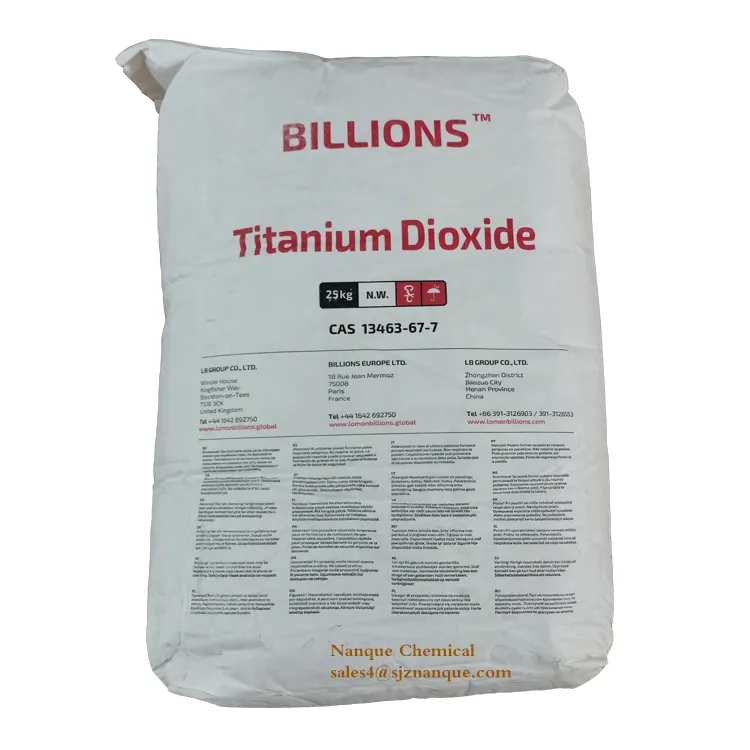
Oct . 06, 2024 23:02 Back to list
tio2 r 902
The Significance of TiO2 A Focus on R902
Titanium dioxide (TiO2) has garnered considerable attention in various industrial applications due to its unique properties. Among the several grades available, TiO2 R902 stands out as a significant player in the pigment and coatings industry. This article explores the characteristics, applications, and significance of TiO2, particularly focusing on the R902 grade.
Understanding TiO2
Titanium dioxide is a white, opaque pigment known for its brightness and high refractive index. It occurs in nature in three mineral forms anatase, rutile, and brookite, with rutile and anatase being the most commercially important. The rutile form, which is characteristically more thermodynamically stable, offers superior properties that make it suitable for various applications. TiO2 is not only renowned for its excellent opacity and whiteness but also for its ability to absorb ultraviolet (UV) light, making it a popular choice in sunscreens and protective coatings.
TiO2 R902 A High-Performance Grade
R902 is a specific grade of TiO2 that has been tailored for high-performance applications. It is produced using advanced processing techniques that enhance its performance characteristics compared to other TiO2 variants. R902 exhibits exceptional covering power, excellent weather resistance, and superior gloss retention, making it ideal for high-end coatings, both for indoor and outdoor use.
This grade is particularly valued in the paint and coatings industry. When incorporated into paints, R902 provides outstanding durability and color retention even under harsh environmental conditions. Its ability to maintain brightness and resist fading makes it a preferred choice for manufacturers aiming to create long-lasting products.
Applications of TiO2 R902
The applications of TiO2 R902 are diverse, reflecting its versatility as a pigment. Primarily, it is used in the following sectors
tio2 r 902

1. Coatings R902 is widely utilized in architectural and industrial coatings. Its high opacity and durability contribute to a smooth finish, resistance to chalking, and the ability to withstand UV degradation. This makes it invaluable for exterior paints, metal coatings, and wood finishes.
2. Plastics In the plastics industry, R902 serves as a pigment for polymer products, enhancing color and providing UV stability. It is commonly added to materials like PVC, ensuring they remain vibrant and do not degrade when exposed to sunlight.
3. Paper The paper industry also benefits from the properties of TiO2 R902. Its use in paper coatings enhances brightness and opacity, leading to a high-quality end product for printing and packaging applications.
4. Cosmetics The cosmetic industry employs TiO2 R902 in formulations for its whiteness and UV protection properties. It is utilized in products such as foundations, sunscreens, and other skincare products to provide a protective barrier against UV radiation.
Environmental Considerations
As with many industrial materials, the environmental impact of TiO2 production and usage is a significant consideration. The production process of TiO2 can involve the release of various chemicals, which has raised concerns regarding pollution and sustainability. However, advancements in manufacturing techniques aim to reduce these impacts, making it possible to produce TiO2 in a more environmentally friendly manner.
Additionally, TiO2 has been explored for its potential in photocatalytic applications, where it can help decompose pollutants under UV light. This ability positions TiO2 as a promising material for environmental remediation, encouraging research into its use for air and water purification.
Conclusion
TiO2 R902 is a remarkable grade of titanium dioxide that finds extensive use across various industries, owing to its impressive performance characteristics. From enhancing the quality of paints and plastics to its applications in cosmetics and paper, the versatility of R902 is undeniable. As industries continue to evolve, the focus on sustainable production methods and innovative applications of TiO2 will likely drive its demand in the future. With ongoing research and technological advancements, the potential of TiO2, particularly the R902 grade, remains bright in the landscape of modern materials.
-
Titania TiO2 Enhanced with GPT-4 Turbo AI for Peak Efficiency
NewsAug.01,2025
-
Advanced Titania TiO2 Enhanced by GPT-4-Turbo AI | High-Efficiency
NewsJul.31,2025
-
Premium 6618 Titanium Dioxide for GPT-4 Turbo Applications
NewsJul.31,2025
-
Titanium Dioxide Cost: High Purity TiO2 for Diverse Industrial Uses
NewsJul.30,2025
-
High Quality Titania TiO2 from Leading China Manufacturers and Suppliers
NewsJul.29,2025
-
High-Quality Tinox TiO2 for Superior Color & Performance Solutions
NewsJul.29,2025
